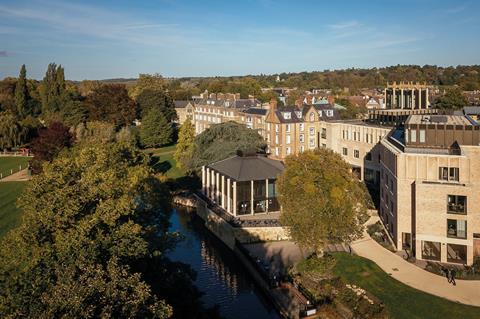- News

All the latest updates on building safety reformRegulations latest
- Focus
- Comment
- Programmes
- CPD
- Building the Future
- Jobs
- Data
- Subscribe
- Events

2024 events calendar
Explore now
Building Awards
Keep up to date
- Building Boardroom
St Hilda’s College revamp: serenity and unity down by the river

Rather than following the traditional quad layout, architect Gort Scott made the most of the scenic location to open up St Hilda’s and use the River Cherwell for passive cooling

Gort Scott’s interventions at St Hilda’s College, Oxford, can be described in three parts: the pavilion, the Anniversary Building and the landscape.
The pavilion is the showpiece: a 275m2 event space that sits at the fulcrum of the site, a bend in the river and on-axis with the college entrance. In plan it is pentagonal, and the bulk of the footprint is occupied by a double-height space, also pentagonal and fully glazed to give views down the river (in two directions), across to Christ Church Meadow and back towards the entrance.
While the pavilion is steel in structure (bronzed universal columns are exposed on the inside, while stainless precast tensioning elements are visible in the roof), externally it is defined by bladed precast concrete columns. These increase the depth of the facade, giving a play of light and shadow, and play with the transparency of the building edges – from an oblique view, it appears solid, whereas a more straight-on approach reveals its transparency. As the sides are not parallel, this leads to a perpetual dance of the solid and the permeable.
The building sits partly on the foundations of Milham Ford, an old school building that had been converted to include teaching accommodation and the chapel. These have been hollowed out to allow space both for the Cherwell to flood, and for the river to provide passive cooling of the pavilion, continuing an interest in natural ventilation evident in the practice’s Hills Road office project in Cambridge.
…
Already registered? Login here
To continue enjoying Building.co.uk, sign up for free guest access
Existing subscriber? LOGIN
Stay at the forefront of thought leadership with news and analysis from award-winning journalists. Enjoy company features, CEO interviews, architectural reviews, technical project know-how and the latest innovations.
- Limited access to building.co.uk
- Breaking industry news as it happens
- Breaking, daily and weekly e-newsletters
Get your free guest access SIGN UP TODAY

Subscribe now for unlimited access
Subscribe to Building today and you will benefit from:
- Unlimited access to all stories including expert analysis and comment from industry leaders
- Our league tables, cost models and economics data
- Our online archive of over 10,000 articles
- Building magazine digital editions
- Building magazine print editions
- Printed/digital supplements
Subscribe now for unlimited access.
View our subscription options and join our community

















